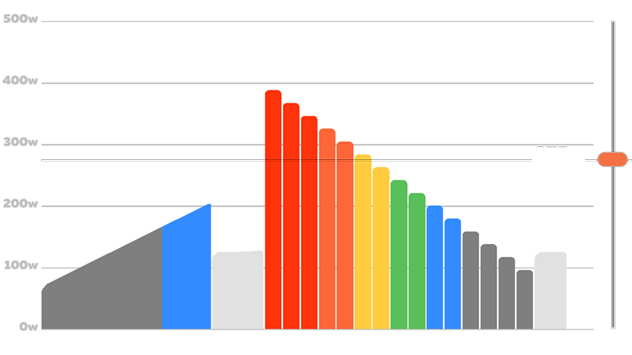Fort Worth, Texas -
Meat Motor has published an article on the potential differences between traditional ramp tests vs. decreasing intensity ramp tests. The article aims to help endurance athletes make training decisions that will better enable them to optimize performance and measure performance gains. A full study summary can be found on the Meat Motor website.
Those familiar with the two methods will know they primarily differ in how they are executed. Traditional ramp tests, wherein activity increases in intensity during the session, may be preferred by many because there appears to be an intuitive link between more strenuous effort and greater progress (which here is measured by the maximum rate of oxygen being breathed in).

Conversely, decreasing intensity ramp tests do the opposite, starting hard but gradually get easier with each block of time. The intuition is different here, but as the article notes, each is supported by independent studies that seem to show that they produce results. As such, it can be difficult for athletes and trainers to make sense of this competing information and decide what is best for their circumstances.
Two recent studies aimed to find out for sure, with the first examining whether cyclists can improve their maximal oxygen consumption (VO2 max) using a novel decremental exercise protocol versus a traditional incremental protocol. Both decremental (DEC) and incremental (INC) cycling tests were performed on alternate days on the same 26 subjects. Most may expect the latter, INC, to do better or at least be equivalent. To the researchers’ surprise, the article says, cyclists achieved a 4.4% higher VO2 max using the decreasing versus increasing protocol.
The article adds, “The researchers theorized that VO2 max plateaus during normal INC tests do not actually represent the cardiovascular system’s maximal oxygen transport capacity. However, it is unclear if DEC protocols provide additional benefits for highly trained cyclists or improve performance.” More research is needed.
While the second study was carried out on runners and compared the maximum amount of oxygen an athlete can utilize during exercise during similar protocols, it may have been considered reasonable to expect results that similarly favored DEC. However, this was not the case. A small difference was noted, but it was not enough to be considered statistically significant.
This led the researchers to conclude that, “Athletes should continue to rely on traditional incremental VO2 max testing to determine aerobic capacity and set appropriate training intensities. While decremental testing may have other uses, maximizing VO2 max does not appear to be one of them based on the current study. Unless and until further research proves otherwise, endurance athletes can trust that their VO2 max plateaus represent their true aerobic potential.”
While these studies’ individual conclusions may appear contradictory and not offer much help, Meat Motor points out that the sport in question may play a role in whether an INC or DEC protocol is advisable for an athlete in training. Endurance athletes, for instance, can probably continue to rely on traditional incremental tests, trusting that VO2 max plateaus during incremental tests represent their maximum physiological limit.
That does not mean that DEC is better for other areas, however. While it may have shown improvement among cyclists in the first study, the fact remains that DEC is an experimental technique that has yet to show a large body of evidence for its efficacy. Meanwhile, INC protocols have proved themselves on numerous occasions already, and there is little reason not to trust them.
Meat Motor has a number of articles that can help athletes, coaches, and trainers keep track of the most recent innovations and discoveries in the world of competitive endurance sports. Readers are encouraged to check out the list of articles on the organization’s official website to learn more.
Alternatively, anyone can get in touch with Meat Motor via phone, email or social media to suggest new areas for the team to explore in future articles. Meat Motor can be found on Facebook, Twitter, Instagram and more. The team welcomes all correspondence from their community.
Breaking down sports science studies to help you become a faster cyclist and endurance athlete.
11536 Twining Branch Cr
Haslet, TX 76052
June 01, 2023 – Meat Motor Decodes New Study on Quercetin's Improvement in Endurance Cycling Performance
May 11, 2023 – Meat Motor Releases Summary of Study Debunking Performance Benefits of Motivational Music for Competitive Cyclists
May 03, 2023 – Meat Motor Website Unveils Key Findings from Sports Medicine Study on Exogenous Ketone Esters for Competitive Endurance Athletes
April 24, 2023 – Meat Motor Unveils Article Distilling the Impact of Pre-Race Warm-Ups on Athlete Performance
April 18, 2023 – Meat Motor Answers When Can Competitive Cyclists Stop Strength Training Before a Race
April 18, 2023 – Meat Motor Sheds Light On Time Trial Pacing
April 18, 2023 – AI Used To Improve Training Stress Score (TSS) Measurements
April 12, 2023 – Meat Motor: Black Currant Improves Endurance Performance
April 07, 2023 – Meat Motor: Do Reverse Ramp Tests Increase V)O2 Max?
August 09, 2021 – Meat Motor Publishes Article Recommending The Coldest Water Bottle For Cyclists